The Florida-Friendly Landscaping™ program (FFL) was established in 1994 to promote environmentally friendly landscapes that conserve water and protect the environment. The primary goal of the program is to encourage the adoption of environmentally friendly landscape behaviors, including using the right plant in the right place. Early efforts to promote Florida-Friendly landscapes emphasized the use of drought-tolerant plants, which created a common misconception that an FFL yard is a "natural-looking" xeriscape with an unkempt appearance. The negative association with a visually unappealing landscape has hampered the promotion of FFL yards and the adoption by homeowner associations (HOAs) as the landscape to promote in regulations and codes.
More recently many homeowners are rethinking their landscape maintenance and plant choices. Many homeowner associations are also considering promoting environmentally friendly landscapes but express uncertainty about recommending FFL because of the need to maintain visual quality. We conducted a study to learn where homeowners and HOA board members agree and disagree on Florida-Friendly landscapes so as to address both groups' concerns and help develop FFL-oriented landscape codes that meet both groups' needs. The study was based on the social marketing approach to behavior change. The intent of a social marketing strategy for the Florida-Friendly program is to make positive environmental changes through landscaping practices. Social marketing research uncovers barriers to adoption, informs decisions such as specifying the behavior we should promote, and helps create strategies for improving adoption. Two groups of HOA board members and two groups of homeowners from two different communities met separately with focus-group moderators to participate in a long interview with scripted questions. An analysis of the focus-group transcripts showed the homeowners and HOA board members collectively had four areas of concern, including aesthetics, environment, social norms, and education. Topic areas provided the framework to develop strategies, activities, and recommendations for how Extension and clientele can work together to promote the use of Florida-Friendly landscapes.
Topic Areas
The primary concerns of homeowners and board members are the basis for developing a connection (something in common) between the groups and for developing recommendations to bridge the differences between the two groups. Activities suggest materials to develop, programs to initiate, and design techniques to use to bring the interests of the two groups together.
Aesthetics: Linking the Look of FFL and HOA Landscapes
Aesthetics is the look or appearance of the yard. The visual quality of a landscape is determined by several factors including the plant material and the hardscape. The aesthetics of plant material is determined by the form, color, texture, and size of the plant. Landscape design incorporates these elements and follows a set of design principles to create a cohesive and interesting look. However, in most HOAs the look of the yard is not about how "pretty" the landscape is—it is about appropriate plant selection, location of plants, and the maintenance of the plants. HOA board members monitor the "look" by checking for the desired maintenance level and appropriately placed plants; they leave the overall design to the homeowner. This concept means that a well-maintained FFL yard will often achieve the desired look of the neighborhood better than a poorly maintained traditional yard.
Primary concern: Both homeowners and HOAs are concerned about having attractive landscapes that maintain property value and environmental health. Board members agreed they would be more willing to recommend/approve FFL yards if they could visualize the look of the yard, and homeowners agreed they would be more likely to install FFL yards if the HOA covenants allowed for some flexibility in the appearance.
Connection: FFL and traditional yards have many features in common, and each can be slightly modified to create a yard that is traditional in look and FFL in function. To create a traditional-style FFL yard, include plants commonly used in the neighborhood that are also Florida-Friendly, and place plants in traditional plant beds that are slightly larger.
Activities and Recommendations to Bring Homeowners and HOAs Together
Define the FFL look—Use images that convey the look of a Florida-Friendly landscape and also conform to the desired community look to show the similarities between the two landscapes (Figure 1). Use example images of landscapes from other communities that have FFL landscapes to show how they meet the aesthetic requirements of their community (Figure 2).
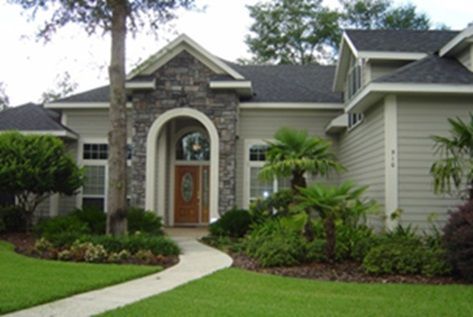
Credit: Florida-Friendly Landscaping™ Program
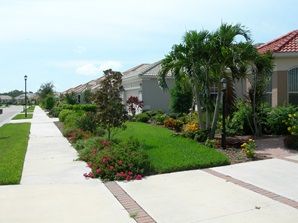
Credit: Florida-Friendly Landscaping™ Program
Write a code intent statement—Craft a design code statement that acknowledges the personal and emotional ties of landscapes. A design code statement should explain the philosophy of a desired "look" in the community and highlight the concept of community pride that landscapes influence.
A statement might read as follows: "Grand Oaks seeks to provide a high quality of life with a comfortable, aesthetically pleasing, and environmentally healthy community for all of its residents. Landscapes that unify the area and build identity collectively make a positive contribution and add significant value to a neighborhood. The neighborhood's fiscal health also depends on personal pride in yard maintenance that acknowledges home values and neighborhood pride. Enhanced visual quality of landscapes also indicates care and activity, which promote a safer, more secure neighborhood."
Define the desired community look—Use images of landscape norms for the neighborhood. Images should include trees, plant beds, and plants around utilities. Other features such as stone/gravel pathways, yard ornaments, fences, furniture, and water features should be included. Plan view drawings of a yard should show minimum percent of turf required and show the same yard as viewed from the street.
Define the use of turf—Use plan view drawings showing traditional front yards with plant bedline layouts that will give the impression of more turf from the road. Homeowners can design their FFL yard to give the impression of a larger turf area from the road. Deeply curved beds that bring "ribbons" of turf from the foreground deep into the yard give the impression of more turf (Figures 3 and 4).
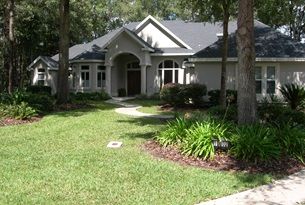
Credit: Florida-Friendly Landscaping™ Program
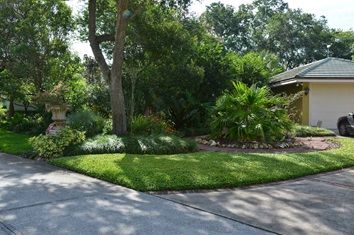
Credit: Florida-Friendly Landscaping™ Program
Define desired plant characteristics—Characteristics should include naturally neat forms, compact growth, clumping groundcovers, easy-to-control spreading plants, wide canopy trees for shade, and flowers for pollinators (Figure 5). These characteristics will help HOA board members understand that FFL yards are not so different from traditional yards. A landscape design technique is to use neat plants that are trimmed in the front of the yard (closest to road) and less manicured plants by the house and deeper into the yard (Figure 6). This gives the impression of a manicured look throughout the landscape.
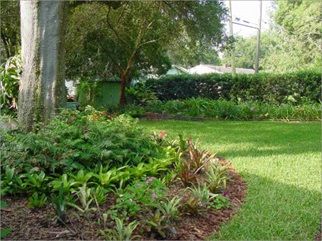
Credit: Florida-Friendly Landscaping™ Program
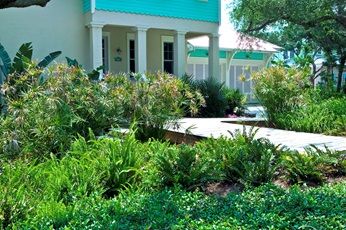
Credit: Florida-Friendly Landscaping™ Program
Environment: Linking Aesthetics to Environmental Health
The appearance of plant material is often used to judge the health of the environment; for example, green turf is considered healthy and a property value asset by many. However, environmental health includes water quantity and quality, and the excessive use of irrigation water and fertilizer to maintain year-around green turf may be harmful to the health of the environment. While HOA board members acknowledged that the environment was important, they felt it was equally important to maintain a desired look. Board members desired landscapes to be both visually appealing and environmentally friendly. Both groups also recognized the importance of using drought-tolerant plants; however, the HOA members were concerned about the look, envisioning desert-type plants in an FFL yard. Homeowners also talked about judging landscapes based on the perceived level of maintenance the landscape would require. Florida-Friendly Landscape yards were seen as requiring less maintenance by homeowners, however HOAs perceive FFL yards as difficult to maintain.
Primary concern: The protection of the environment was a concern for both groups, but the HOA board members were not convinced that the desired look could be achieved if environmental issues took precedent. Some felt the best compromise was for neighborhoods to reduce water use, but not to the extent of compromising the look of the turf.
Connection: Find ways to protect the environment without compromising aesthetics. For example, colorful shrubs that conserve water, irrigation systems that conserve water yet maintain the green color of turf, and evergreen plants that attract pollinators.
Activities and Recommendations to Bring Homeowners and HOAs Together
Link aesthetics and environmental health—Demonstrate the relationship between aesthetics and environmental health by juxtaposing photos of yards with turf and few plants to photos of yards with a greater number and variety of plants. Show images of over trimmed and incorrectly pruned shrubs and improperly mulched plant beds that demonstrate what not to do alongside images of more attractive shrubs and plant beds maintained with best management practices (Figures 7 and 8).
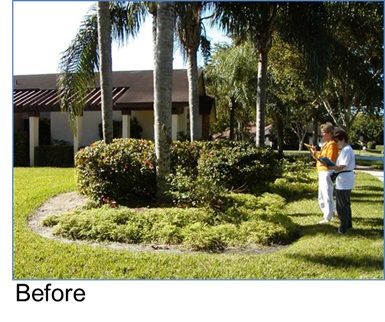
Credit: Florida-Friendly Landscaping™ Program
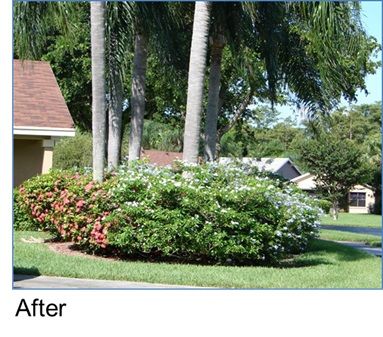
Credit: Florida-Friendly Landscaping™ Program
Define an environmentally friendly yard—Describe the features and benefits of an environmentally friendly yard and how maintaining the yard with environmentally safe practices will improve the value of the landscape. This will help homeowners and board members understand why it is in their best interest to be environmentally friendly.
Relate wildlife to plants and aesthetics—Describe the types of wildlife that a traditional yard might attract and the additional wildlife an FFL landscape would attract. Identify aesthetically pleasing plants and landscape features that also attract more desirable types of wildlife (Figure 9).
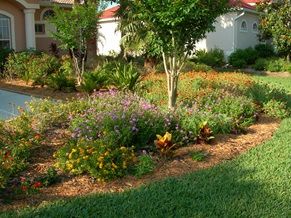
Credit: Gail Hansen, UF/IFAS
Link water conservation to plant groups—Suggest drought-tolerant plant combinations for yards in north, central, and south Florida that would help homeowners purchase and use groups of plants that have the same water requirements and create aesthetically pleasing combinations.
Explain ecosystem services—The concept of ecosystem services can be simplified by describing how different groups of plants, such as trees, groundcovers, and shrubs, benefit the environment and provide "services," such as cleaning water and air for humans.
Contrast drought-tolerant and arid plants—Compare drought-tolerant plants with plants typically associated with xeriscape landscapes. The description should emphasize that a variety of plants are drought-tolerant but do not look like desert plants or landscapes.
Social Norms: Linking Landscapes through Landscape Codes
The social norms of home landscapes center around the idea that the accepted and expected visual appearance of front yards is valued by many to maintain a cohesive community look and high property values. Many homeowners purchase property in HOA communities for insurance that visual standards in their neighborhood will be followed and maintained. There is typically a high desire to "fit in" with the norms, but also to express some individual personality in landscapes. Social norms for landscapes are rarely a topic of conversation among neighbors unless someone on the street has a very unconventional or poorly maintained landscape. Neighbors are sometimes distressed by the unwillingness of others to follow the norms because it affects the perception of the entire neighborhood. Although FFL is often perceived to be less well maintained, most people would not be able to make a distinction between a properly maintained traditional yard and an FFL yard; thus the concern of being outside the norm ultimately is about maintenance of either type of yard.
Primary concern: The role of regulations and the role of the HOA board members was a primary concern to both homeowners and HOAs. Both groups agree that FFL principles and codes are useful to maintain property value, increase safety, provide a sense of community, and improve neighbor relations. However, homeowners often saw the enforceable codes desired by the board members as too strict.
Connection: Write clear codes. Well-written codes are the key to addressing the social concerns of the homeowners and the HOA board members. Codes can guide homeowners in landscape decisions that allow them to have their desired landscape and still fit the neighborhood norm, and they will assist the board members in monitoring the yards with more consistency.
Activities and Recommendations to Bring Homeowners and HOAs Together
Use images in codes—Landscape codes should show images of aesthetically pleasing landscapes that fit the desired look in the community and explain the reasoning for the look in terms of the character of the community and why it enhances the value. For example well-cared-for yards show community pride and give outsiders the impression that there are "eyes on the street," in other words, that people are aware of what is going on in their neighborhood and are watching out for their neighbors. Studies have shown that there is less crime and fewer problems in neighborhoods where care and upkeep is obvious.
Enforce through measurable codes—The challenge for regulating codes is to allow for some personal expression while still making the codes clearly enforceable. This generally means that whatever is being enforced must be measurable. The best measurements are dimensions, counts, and proportions. Height and width are the easiest to measure, for instance, the height and spread of shrubs (Figure 10) and the size of plants for designated areas of the yard (large plants on property boundaries and medium shrubs under windows). Counts are also measurable, for instance, the exact number of shrubs or trees allowed in the yard. Types of plants for designated areas of the yard, for instance, edibles in the back yard, certain trees in front yard, and shrubs for the side yards (Figure 11), are also easier to regulate. Percent of a space (for example percent of front yard that is turf) is more difficult to measure with accuracy, but simple square-foot areas can be calculated. Codes should also include features not allowed in the front yard, such as raised vegetable gardens or dog runs.
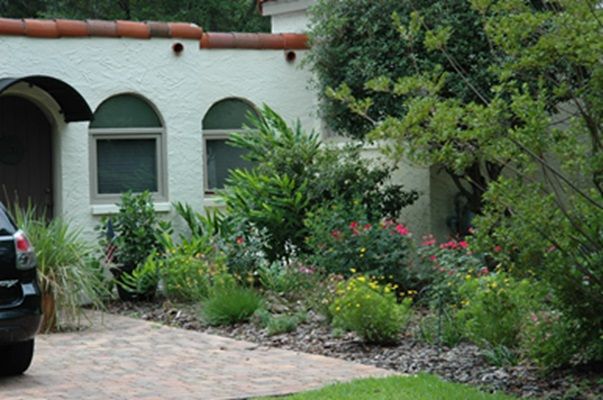
Credit: Erin Alverez, UF/IFAS
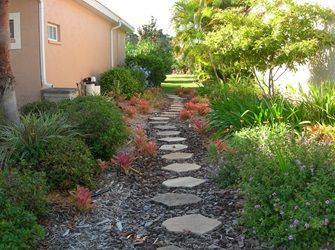
Credit: Gail Hansen, UF/IFAS
Clarify enforcement standards—If HOA covenants are clear about what will be enforced, homeowners will see that FFL landscapes will not be enforced differently. The enforceable elements are the same in FFL landscapes and traditional landscapes.
Maintain look in code revisions—Changes should be made to codes without compromising the intended "look" of the community. For example, most landscapes can look good with less turf if they are designed to optimize the view (perspective) of the turf from the street. Homeowners can maintain a manicured look if they place regularly trimmed plants in the foreground and plants that are pruned less often in the background.
Codifying Right plant/Right place—The first FFL principle, Right Plant/Right Place, can be codified by recommending types and locations for plants based on function and aesthetics (Figures 12 and 13).
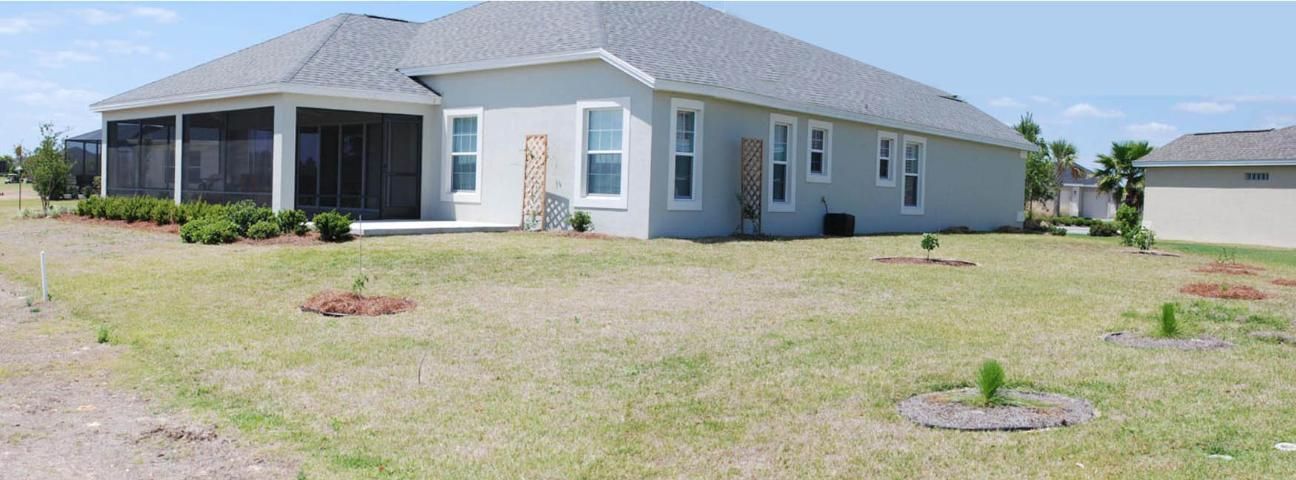
Credit: S. P. Turnipseed
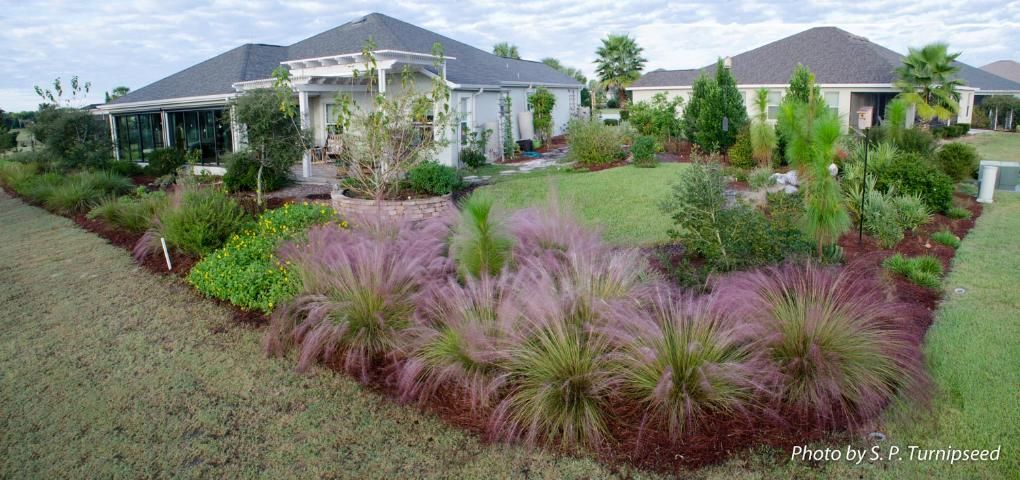
Credit: S. P. Turnipseed
Education: Linking Landscape Knowledge and Perceptions
Many homeowners and HOA board members wanted to know more about Florida-Friendly landscapes; they expressed confidence in the concept of FFL as water-saving, but uncertainty about the look of an FFL yard. Both groups expressed a need for good sources of information with examples.
Primary concern: Both groups desired easy–to-understand materials with many photo examples. HOA members were not confident that FFL should be written into HOA codes until they had a clear visual concept of the aimed-for landscape.
Connection: Understand the differences. Knowing that homeowners' and HOA board members' perceptions of Florida-Friendly landscapes differ will help Extension agents and Master Gardeners work with both groups to develop information and programs. Developing new materials provides a good opportunity to create the community version of an FFL yard.
Activities and Recommendations to Bring Homeowners and HOAs Together
Engage communities—HOA boards can produce their own in-house educational material with guidance from UF/IFAS Extension agents. Homeowners will perceive the board to be more aware and involved in creating more environmentally friendly and aesthetic landscapes. If homeowners feel the board supports these types of landscapes, they will be more willing to compromise on some issues such as stones, native plants, or amount of turf.
Target new homeowners—HOAs should develop a landscaping advice kit for new homeowners when they purchase their home. Information should include contact names and numbers of the county UF/IFAS Extension office and websites to access UF/IFAS materials.
Personalize materials—Educational material should be tailored to reflect the desired looked of the community and the type of plant material that will grow best in the area. Maintenance costs and practices should be included in the materials.
Demonstration landscapes—FFL landscapes in common areas can be used to demonstrate plant material and plant combinations homeowners can use in their yards. (Figures 14 and 15).
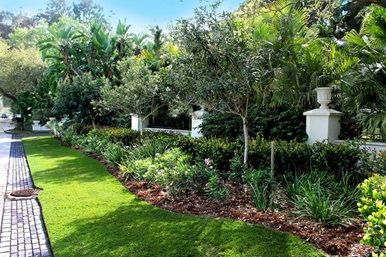
Credit: Florida-Friendly Landscaping™ Program
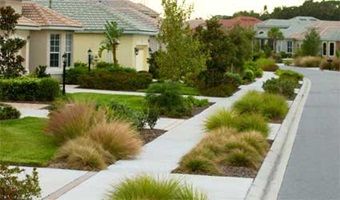
Credit: Florida-Friendly Landscaping™ Program
Engaging Homeowner Associations
Homeowner associations should develop their own version of an FFL landscape. The review boards can work with a landscape designer who is familiar with FFL principles to craft a version of an FFL yard that meets their needs for aesthetic quality and provides the environmental benefits desired by homeowners who want to convert their yard to FFL. Educational materials with graphics such as photos and diagrams are important to the success of developing an HOA-specific FFL landscape design guide. People are more likely to accept and agree on change if they can picture the outcome of the proposed change. The architectural review board (ARB) should include a person who is knowledgeable about FFL landscapes and plant material. They can help other board members understand recommended FFL maintenance techniques and see that less maintenance does not mean "not maintained." Many research participants could not visualize an FFL landscape, but they expected more plants and less turf and more aggressively growing plants, which board members thought would create monitoring difficulties because the FFL yards would look significantly different from and contain more plant material than traditionally landscaped yards in the same neighborhood. Clear photos of FFL yards that still have a traditional look (containing turf, for example) will convey to concerned HOA board members that the landscape is not significantly different and therefore monitoring and maintenance will not require a different set of codes.